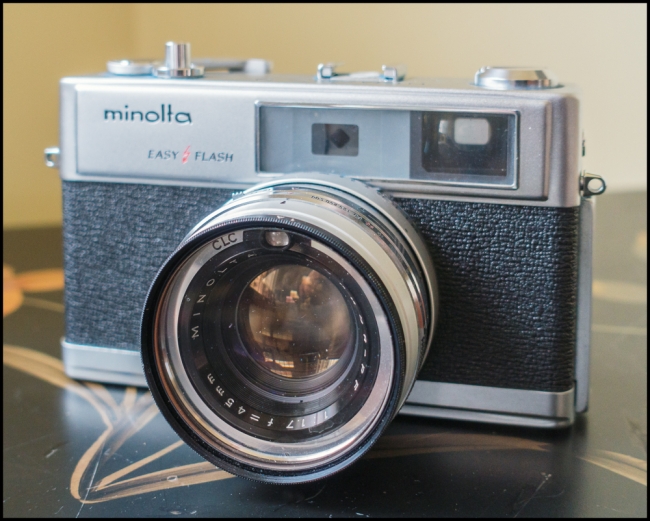This is one solid camera. It’s big and heavy, but at the same time feels quite comfortable in my hands.
The exposure system is intriguing. For fully automatic exposure you set both the aperture and shutter speed to ‘A’ and shoot away (or at least I hope you do. I still waiting for results).
If you don’t want to leave all exposure decisions to the camera you can use the camera in fully manual mode. As the manual explains:
For unusual conditions or for special effects and techniques, you may want to operate the camera manually selecting the shutter speed and aperture yourself. 1) Move the “A” marks away from the “arrow” by pressing the AUTO release button (on the right side of the lens) and turning the shutter speed ring. Then, press the button once again in order to disengage the diaphragm ring. 2) You are now in complete command of the camera (just as with any fine 35mm camera) and can set any shutter speed or aperture opening combination you wish.
Of course you’ll need to have an instinctive grasp of exposure, follow the the “sunny 16“ rule or use an external meter for this to work.
And that’s not all. You can also meter semi-automatically:
Even after disengaging the automatic system you can, if you wish, use it as and independent exposure meter. When using the Minolta Hi-matic in this way, aim at your subect, and watch the point to which he indicator needle moves on the EV scale. Set this EV number in the EV window on the lens barrel. 1) Press the AUTO release button and set any shutter speed you wish. 2) Read the EV figure indicated by the needle in the viewfinder. Then set the figure in the EV window by turning the diaphragm ring 3) You may also set the aperture opening first and then move the shutter speed ring to obtain the correct EV number.
It all sounds a bit “fiddly” and I haven’t yet plucked up the courage to try this method (for my first roll I used fully automatic operation).
The lens is a Minolta Rokkor PF f1.7 45mm and if it’s like other Rokkor lenses I’ve used it will be a good performer.
Focus is via a tabbed ring on the lens barrel and the coupled rangefinder is well defined in quite a large and clear viewfinder.
Loading is much as you would expect except for one unexpected useful feature: a small window that shows you if the film has loaded properly and is advancing correctly.
The film advance level has rather a long throw (which doesn’t bother me much) and the shutter release requires quit a lot of pressure (which does bother me. I wouldn’t be surprised if I got some blurry pictures as a result of camera shake).
As with many fully automatic exposure camera it bothers me that I don’t know what aperture and shutter speed settings the camera has chosen. I suppose if I really want to know I can set them myself using either the fully manual or semi-automatic modes described above. I’ll try these modes for the next roll.
The camera came with one of the least objectionable every ready cases I’ve come across. It was in very good condition and it was easy to remove the entire front half leaving only a half case, which didn’t get in the way of picture taking.
All in all I really liked this camera and I’m looking forward to seeing the results.
For a more thorough review see this one on K2 photography.

